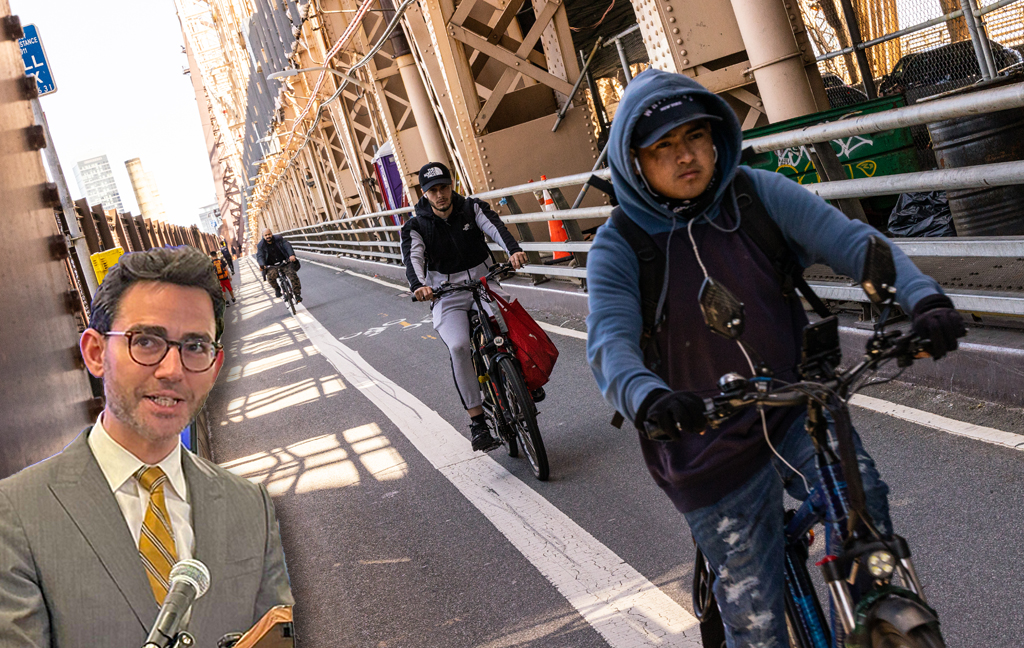 Thirty years ago the health arguments against car-dependence were 90 percent about air pollution and 10 percent about physical inactivity. Now, with tailpipe pollution down and obesity and diabetes up, those percentages are reversed. The latest evidence is a valuable new report, Steps to Get New Yorkers Moving (PDF file), from the Public Health Association of New York City.
Thirty years ago the health arguments against car-dependence were 90 percent about air pollution and 10 percent about physical inactivity. Now, with tailpipe pollution down and obesity and diabetes up, those percentages are reversed. The latest evidence is a valuable new report, Steps to Get New Yorkers Moving (PDF file), from the Public Health Association of New York City.
Our city has a bad case of "sedentitis," says the report. One in four New Yorkers doesn't exercise, and three of four don't exercise enough. One in five of us is obese, one in thirteen has diabetes, and 40% of schoolkids are overweight.
Okay, we knew that. What's different here is PHANYC'S solution: not banning transfats or greening school lunches - good things, to be sure - but "increasing opportunities for physical activity in our 6,000 miles of streets, 1,000+ schoolyards, 29,000 acres of parks, 600,000+ businesses, and 578 miles of waterfront."
And because most New Yorkers are short on time or cash or both, the City "needs to make the places where we spend most of our time - streets, parks, waterfronts, schools, workplaces and homes - more suitable for safe, accessible and affordable physical activity." Topping PHANYC's priorities is a bunch of ways to make cycling and walking easier and safer: cutting traffic, curbing speeding, friendlier sidewalks and streets, and overhauling City DOT so it stops "putting the needs of cars and drivers first."
We knew that too. But what elicits yawns when uttered by biking and walking advocates carries weight coming from public health types. Which led us to ask why this venerable association of health care providers, health administrators, researchers, scientists and professors chose to focus on physical (in)activity.
"We're very concerned about the rise in obesity and diabetes in New York City, said PHANYC president Nick Freudenberg, who teaches public health at Hunter, in an e-mail message. Diabetes is now the fourth leading cause of death here, and obesity is a recognized factor in morbidity and mortality. "We believe that improving opportunities for physical activity is one of the best ways to reduce and prevent obesity and diabetes," Freudenberg said. "In addition, physical activity has many other benefits, reducing other physical and mental health conditions and improving well-being."
I couldn't have said it better myself. But why not just exhort people to exercise? "We chose a policy focus," Freudenberg replied, "because we feel that public action can facilitate, or impede, the needed individual behavior change." To replace sedentitis with healthful physical activity, "The city needs to move further from reliance on automobiles as a mode of transport, invest substantially in improving school conditions, and improve the quality and safety of New York's parks and recreation facilities."
"Those fruits aren't so low," cautioned Freudenberg, with the wisdom of one who understands the vast power of the city's car-owning minority.
Still, the PHANYC report is a big step in the right direction at the right time. Mayor Bloomberg casts himself as a public-health guy. He gave $55 million to Johns Hopkins University, where the School of Public Health now bears his name. As mayor, he curbed cigarette smoking and is now weaning restaurants off artery-clogging trans-fats. He could hit the trifecta and reap perhaps his biggest public-health bonanza yet - physically active New Yorkers - by pulling the plug on car-dominance here once and for all.
Photo: Mike tn on Flickr





